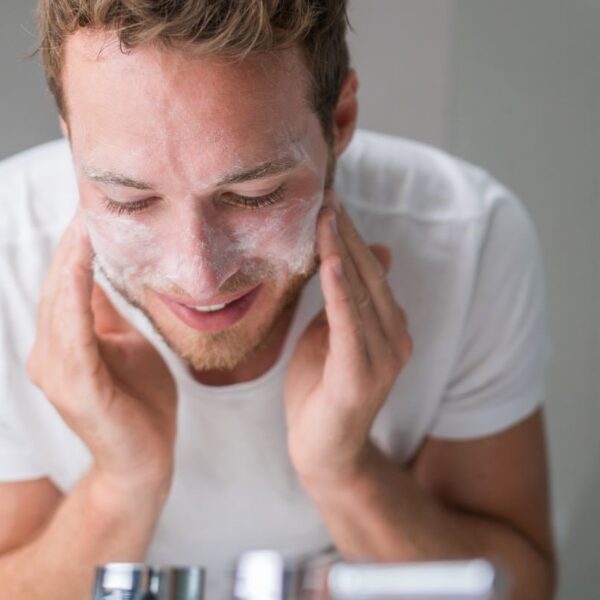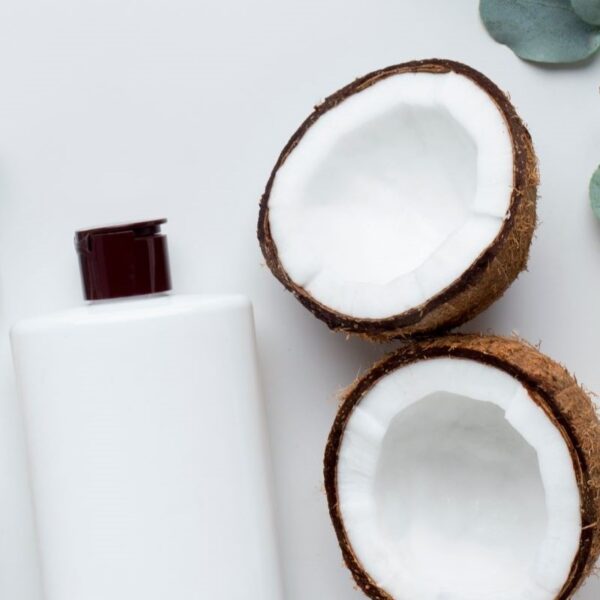Benzaldehyde, an aromatic compound primarily known for its characteristic almond-like odor, has a range of applications across numerous industries. In personal care products, benzaldehyde’s unique properties have made it a valuable ingredient in formulations. This article explores benzaldehyde’s uses and applications in personal care product formulations, discussing its role, benefits, and potential concerns in consumer safety and product quality.
What is Benzaldehyde?
Benzaldehyde is an organic compound consisting of a benzene ring with an aldehyde substitute. It is found naturally in glycoside amygdalin and, as an aromatic aldehyde, is known for its distinct taste and odor. It has a pleasant, sweet, aromatic almond note and tastes the same, with a slight, sweet, aromatic bite.
Source: Wikipedia/Benzaldehyde
Benzaldehyde is a versatile ingredient with many valuable properties. Its pleasant aroma, preservative properties, and solvent abilities make it essential in many formulations. This colorless to slightly yellowish oily liquid is known as bitter almond oil due to its almond-like scent.
Synonyms for Benzaldehyde include Artificial Almond Oil, Benzenecarbonal, Benzoic Aldehyde, Benzenecarboxaldehyde, Benzenemethylal, Benzene Carboxaldehyde, Bitter Almond Oil (synthetic), Phenyl Formaldehyde, and Phenyl Ethanol Aldehyde (Research Institute for Fragrance Materials [RIFM] 2001; Pepe et al.2002).
It is the simplest aromatic aldehyde and one of the essential ingredients in fragrance crafting. It also has wide application in the food industry as a flavor ingredient and in personal care products as a fragrance.
Source & Production
Natural Sources
This simple aromatic aldehyde can be derived from various natural sources. As with many desirable aroma chemicals, there is no direct plentiful natural source for benzaldehyde. The sole noncontroversial commercial source of natural benzaldehyde is the nut meat of apricots, peaches, prunes (plums), and bitter almonds. Current production is based on the by-product nuts from fruit processing of peaches, apricots, and prunes (plums).
Synthetic Sources
Chlorination of Toluene: It can also be manufactured synthetically from toluene found in crude oil for industrial usage. A series of chemical reactions are completed in which toluene reacts with chlorine. Those reactions lead to the formation of benzal chloride, which can be further treated with water (hydrolysis of Benzal Chloride) to form benzaldehyde.
Benzaldehyde can also be synthesized by oxidizing benzyl alcohol and carbonylation of benzene.
Use and Applications in Cosmetics
One of the primary uses of benzaldehyde in personal care products is its aromatic properties. It provides a pleasant fragrance that is widely used in perfumes and colognes. Its aroma is often described as a combination of marzipan, cherries, and almond. It is a critical ingredient in many perfumes, especially those with a floral fragrance profile.
| Fragrance Ingredient | Benzaldehyde plays a prominent role in fragrance creation especially suitable for Nutty, Fruity fragrances. It can add depth and complexity to a fragrance. It has an almond-cherry-like aroma, making it an appropriate ingredient addition for unisex personal care product range like cologne, body butter, and body mists, to name a few. As the head of the unique aroma, it is a trace formula for fragrances, such as lilac, white, violet, jasmine, acacia, sunflower, sweet plum, orange flower, Tofu pudding, etc.Also, it is used in soap. Benzaldehyde is also commonly used to provide a light, pleasant aroma to many other cosmetic products, including powders, foundation, and skin moisturizers. |
| Flavor Ingredient | Flavors used in personal care and cosmetic products are usually synthetic and designed to give the product a pleasant smell and taste. These flavors are usually derived from essential oils, fruit extracts, and other natural sources. Benzaldehyde is used as a flavor ingredient for specific market sections such as lip care products like lip salves, lip balms, scrubs, body butter, body scrubs, etc., imparting the almond-like flavor. Because cherries and almonds are so close in flavor and fragrance, benzaldehyde is common in recreating natural cherry and almond flavors and aromas. |
Top Applications
| Industrial Applications | Dyes (acridine and aniline dyes), flavoring agents, perfumes, and the manufacturing of several other organic compounds. |
| Personal Care Products | Body butter with almond fragrance, lotions, creams, and hair care range with almond-cherry characteristics. |
Properties of Benzaldehyde
| Appearance at 25 °C | Colorless to pale yellow liquid |
| pH (10% Aqueous) | 6.5-7.15 |
| Molecular Weight | 106.12 |
| Specific Gravity at 25◦C | 1.041-1.046 |
| Density at 25°C (g/cm3) | 1.041-1.046 |
| Refractive Index at 20°C | 1.5440- 1.5470 |
| Solubility | Slightly soluble in water and is completely soluble in ethanol and diethyl ether |
| Acid Value (KOH/g) | 5.00 max |
| Boiling Point | 178 – 179°C |
| Melting Point | −26 °C |
| Vapor Pressure at 26◦C | 1 mm Hg |
| Vapor Density | 3.66 (air=1) |
| Viscosity | 67-70 mP |
| Odor | Characteristic, bitter almond |
| Shelf Life | 12-18 months |
| Storage Conditions | – Store in a well-filled, tightly sealed container in a cool, dry place. – It is recommended to store the product away from direct sunlight in full, tightly sealed containers in a dry and well-ventilated area. |
Organoleptic Properties of Benzaldehyde
| Odor Type | Fruity |
| Odor Strength | High, recommended smelling concentration – In 10.00% solution or less |
| Odor Description | Strong, sharp sweet-bitter almond cherry. Fruity, Powdery, Nutty |
| Blends well with | Vanillin, Coumarin, Benzophenone, and Heliotropin |
Formulation example: Solid Perfume
Benzaldehyde is a common ingredient in the formulation of perfume products due to its multifunctionality. Check out the following formulation example:
| PHASE | INCI NAME | TRADE NAME | SUPPLIER | % Wt. |
| 1 | Diisostearyl Malate | COSMOL™ 222 | Ikdea/ Kobo Products | 18.00 |
| Ozokerite | TECWAX OZOQUERITA | Cosmotec | 8.00 | |
| Phenyl Trimethicone | CPF-3300@10cSt | Avantor/KoboProducts | 7.00 | |
| Polyethylene (And) Microcrystalline Wax | PM Wax 82 | Kobo Products | 6.00 | |
| Isononyl Isononanoate | SALACOS® 99 | Ikeda/KoboProducts | 5.00 | |
| Beeswax | Tecwax Abelha | Cosmotec | 2.00 | |
| 2 | Polymethylsilsesquioxane | MST-547 | Kobo Products | 15.00 |
| 3 | Cyclopentasiloxane | Xiameter PMX-0245 | Dow Corning | 30.00 |
| Dimethicone (And) Dimethicone/Vinyl Dimethicone Crosspolymer | CXG-1104 | Avantor/KoboProducts | 3.00 | |
| Silica | MSS-500/H | Kobo | 3.00 | |
| 4 | Benzaldehyde, Apricot Kernel Oil | Almond Fragrance Blend | Vigon | 3.00 |
| Total: | 100.00 | |||
Procedure for Creating a Solid Perfume
1. Combine Part 1 and heat to 85ºC
2. Add Part 2 and mix well.
3. Cool the formula to 70ºC.
4. Add Part 3 and mix until homogeneous.
5. Combine Part 4, add to Parts 1, 2, and 3, and mix.
6. Pour into components while hot.
Formulation Considerations
- As mentioned, Benzaldehyde is miscible in volatile oils, fixed oils, ether, and alcohol, making these a suitable medium for fragrance blending rather than using water as the vehicle.
- Fragrance should be added at around 35-38 °C
- At its most potent concentration, it has an intense and bitter flavor or aroma – however, when diluted or sweetened, it has a sweet almond flavor or fragrance.
Formulation Dosage
The maximum usage level in the personal care industry per the IFRA maximum acceptable concentrations in finished products for Benzaldehyde are:
| Category | Usage Level |
| Products applied to the lips | 0.045% |
| Products applied to the Axillae | 0.014% |
| Products applied to the face/body using fingertips | 0.27% |
| Products related to fine fragrances | 0.25% |
| Body lotion products applied to the face and body using thehands (palms), primarily leave-on | 0.064% |
| Body lotion products applied to the face and body using the hands (palms), primarily leave-on | 0.064% |
| Face moisturizer products applied to the face and body using the hands (palms), primarily leave-on | 0.064% |
| Baby Cream, Oil, Talc | 0.021% |
| Products with oral and lip exposure | 0.15% |
| Products applied to the hair with some hand contact | 0.52% |
| Hand cream products applied to the face and body using the hands (palms), primarily leave-on | 0.21% |
| Products with body and hand exposure, primarily rinse-off (bar soap) | 0.49% |
Source: https://www.cir-safety.org/sites/default/files/Benzaldehyde.pdf
Safety & Regulatory Considerations
While benzaldehyde plays a significant role in personal care product formulation, its use comes with safety considerations. Benzaldehyde can cause skin and eye irritation and may be harmful if ingested or inhaled in large amounts. Therefore, organizations like the U.S. Food and Drug Administration (FDA) and the European Union’s Regulation on Cosmetic Products regulate their concentration in personal care products to ensure consumer safety.
| FDA Information | The Food and Drug Administration (FDA) allows benzaldehyde as a flavoring agent or adjuvant. |
| EU Information | In the EU, the EU Cosmetics Regulation (EC) No 1223/2009 harmonizes cosmetics regulation across its member countries. The rule lists benzaldehyde as an approved fragrance ingredient. However, if a product contains benzaldehyde, the manufacturer must include “contains benzaldehyde” on the label if its concentration exceeds 0.001% in leave-on products and 0.01% in rinse-off products. |
| The FEMA GRAS assessment of benzyl derivatives used as flavor ingredients. Food Chem Toxicol 2005; 43: 1207 – 1240 | Benzaldehyde, a benzyl derivative, has FEMA GRAS status as a flavoring agent. |
| SCCS Opinion on fragrance allergens in cosmetic products (June 2012 meeting) | Contact Allergen Status: Benzaldehyde is identified in Annex I as being a mild contact allergen (+, to indicate up to 10 positive test reactions). |
| Flavoring regulation, Europe | According to the default maximized survey-derived daily intake approach, 41 flavoring substances allocated to structural class I (including Benzaldehyde) have intakes in Europe from 0.001 – 610 µg/capita/d, which are below the threshold of concern value for structural class I (1800 µg/person/d). |
| Japan Regulations | Benzaldehyde is not included on the list of ingredients that must not be combined in cosmetic products that are marketed in Japan (Ministry of Health, Labor and Welfare [MHLW] 2001a) or on the list of restricted ingredients for cosmetic products that are marketed in Japan (MHLW 2001b). |
Identification Numbers
| CAS Number | 100-52-7 |
| EC Number | 202-860-4 |
| FEMA Number | 2127 |
Safety & Toxicity of Benzaldehyde
- Toxicology studies indicate that it is safe and non-carcinogenic in the concentrations used for foods and cosmetics and may even have anti-carcinogenic (anti-cancer) properties.
- Skin sensitization: The CIR Expert Panel has expressed concern regarding the limited irritation and sensitization data available for Benzaldehyde. Although one evaluation of sensitization screening methodologies reported sensitization reactions in animals Benzaldehyde, other animal tests indicated no sensitization.
- Based on the data presented in this safety assessment, the CIR Expert Panel concluded that Benzaldehyde is safe in cosmetic products.
Fun Facts about Benzaldehyde
- Benzaldehyde is used as a bee repellent. A small amount of benzaldehyde solution is placed on a Fume Board near the honeycombs. The bees then move away from the honeycombs to avoid the fumes. The beekeeper can then remove the honey frames from the bee hive with less risk to both bees and beekeepers.
- The taste you associate with cherry cola? That’s thanks in part to benzaldehyde. It is used to create that distinctive flavor.
- Benzaldehyde has been used in forensic science. It can react with certain substances found in fingerprints, helping to make them more visible.
- In art conservation, benzaldehyde vapor softens and removes aged varnish from old paintings without damaging the paint.
Additional Resources
- PubMed – National Center for Biotechnology Information
- Creating Almond Flavor and Fragrance with Natural Benzaldehyde – Advanced Biotech
- Registration Dossier: Benzaldehyde – European Chemicals Agency (ECHA)
- Benzaldehyde – Wikipedia
- https://www.cir-safety.org/sites/default/files/Benzaldehyde.pdf
- https://fragrancematerialsafetyresource.elsevier.com/sites/default/files/100-52-7_0.pdf
- https://ifrafragrance.org/standards/IFRA_STD_007.pdf
- https://ec.europa.eu/health/scientific_committees/consumer_safety/docs/sccs_o_102.pdf
- Final Report on the Safety Assessment of Benzaldehyde1- DOI: 10.1080/10915810600716612





